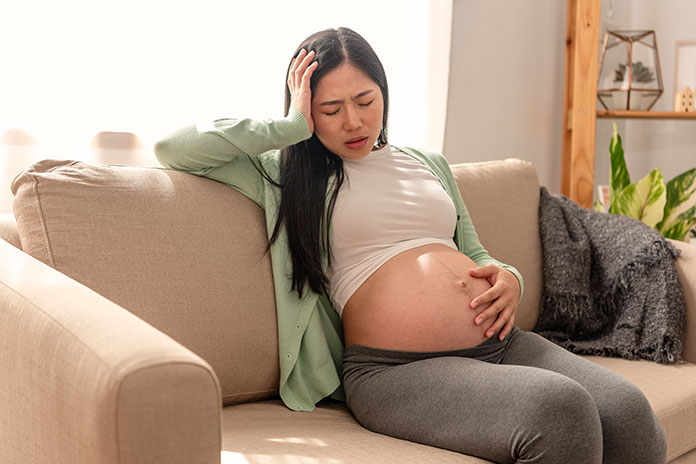Future mothers know that a whole host of minor inconveniences and various discomforts often accompany pregnancy. And pain under the Chest, located at the level of the ribs, can sometimes be part of it. What could this pain be due to? Are they worrying? And how to relieve them? The answers to your questions are in the rest of this article.
Table of Contents
Pain Under The Pregnant Chest: What Is It Due To?
Feeling pain under the Chest, at the ribs, on the right or left side, or even in the middle is a fairly common phenomenon when you are pregnant. Although very uncomfortable, these pains can be completely benign or, on the contrary, be one of the signs of a much more severe problem.
In more detail, subcostal pain during pregnancy can be linked to:
Increased Relaxin Levels
Relaxin is a hormone produced during pregnancy that helps relax the ligaments and soften the uterus to allow it to distend during the growth of the fetus. This hormone works by modifying the composition of collagen, a substance present in our tissues, to make it more flexible and elastic. These effects are then felt at the level of the ligaments and joints of the entire body. Thus, during pregnancy, the pain experienced at the subcostal level can be attributed to all these transformations induced by relaxation.
The Evolution Of The Growth Of The Uterus And The Baby
As the fetus grows, the uterus distends to accommodate this growth. In doing so, it pushes the abdominal viscera upwards by compressing the diaphragm and the lower part of the ribs, which can be the cause of subcostal pain. In addition to the increase in the size of the baby, its position in the uterus or the fact that it kicks at the level of the ribs of the mother-to-be can also be involved in the appearance of localized pain under the Chest. These pains can thus be increased in a sitting position or during the phases of inspiration.
Also Read: Discover All The Good Reasons To Eat Nuts Regularly
Inflammation Of The Sternum Or Costal Cartilages
During pregnancy, the rib cage increases in diameter to accommodate the baby. These remodelings can cause inflammation of the tip of the sternum or the rib cartilage (costochondritis), which is the cause of chest pain.
DigestiveI Disorders
Nausea, vomiting, and gastroesophageal reflux, which are very common in pregnancy, can also cause subcostal pain. Most of these discomforts are due to a reduction in the tone of the lower esophageal sphincter under the effect of estrogens and progesterone.
A Change Of Posture
As the baby grows, the mother-to-be’s belly shifts forward, and her weight increases, the pregnant woman’s center of gravity shifts. It is, therefore, typical for her posture to evolve and even more so if she is trying to compensate for lower back pain in the lumbar region and the sciatic nerve, which is also very common during pregnancy. This change in posture can, therefore, also cause or increase subcostal pain.
Preeclampsia
Preeclampsia, also known as “pregnancy toxemia,” is a severe pregnancy pathology that requires hospitalization. It is caused by an abnormality of the blood vessels of the placenta, which causes fetal distress and high blood pressure in the mother. While preeclampsia does not always cause symptoms, it can also manifest as severe pain under the ribs, especially on the right side. Other signs may include swelling of the hands, feet, and face, persistent headaches, ringing in the ears, and black or bright spots in the field of vision.
What To Do If You Have Pain Under Your Chest During Pregnancy?
With the exception of preeclampsia, which requires immediate medical attention, pain below the ribs is rarely a cause for concern in pregnant women. However, it is recommended to systematically speak to a doctor or midwife/midwife in order to precisely identify the origin and rule out any possible risk for the future mother and the baby.
If the pain is physiological, it is possible to relieve it by avoiding prolonged sitting postures as much as possible. It is advisable to give your abdomen a little more room by lying down for a few minutes during the day on your back with a small cushion tucked under your knees and your arms outstretched. Accompany these stretches with deep breathing, trying to inflate your stomach to relax the diaphragm as much as possible and restore mobility.
Practicing gentle physical activity such as walking or swimming every day, if it is not contraindicated during your pregnancy, can also help mobilize your rib cage and reduce pain.
Also, do not hesitate to use a pregnancy ball to relieve your lower back pain and to practice gentle stretching. Ask your midwife to show you the correct actions or postures to adopt.
You can also schedule a session with an osteopath who will help you relieve your rib pain through gentle manipulations aimed at releasing tension in the rib cage and vertebrae.
If your pain is related to gastroesophageal reflux, consider splitting your meals and avoiding spicy, fatty, or acidic foods, which can cause heartburn. Make sure you eat slowly, chewing your food well. Avoid lying down immediately after eating, and elevate your head and shoulders when lying down. Finally, do not take any medication or “home” remedies during your pregnancy to relieve your pain without prior medical advice.
Also Read: Triglycerides: The Risk Of Junk Food


